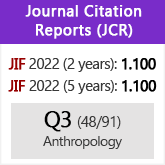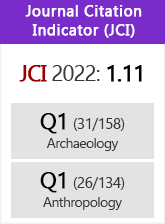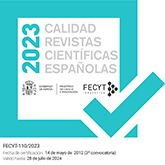The “Steppe Belt” of stockbreeding cultures in Eurasia during the Early Metal Age
DOI:
https://doi.org/10.3989/tp.2008.08004Keywords:
Nomadic stock-breeding cultures, Eurasia, Early Metal Age, Archaeometallurgy, Radiocarbon chronologyAbstract
The stock-breeding cultures of the Eurasian “steppe belt” covered approximately 7-8 million square km2 from the Lower Danube in the West to Manchuria in the East (a distance of more than 8000 km). The initial formation of the “steppe belt’cultures coincided with the flourishing of the Carpatho-Balkan metallurgical province (V millennium BC). These cultures developed during the span of the Circumpontic metallurgical province (IV-III millennium BC). Their maturation coincided with the activity of the various centers of the giant Eurasian and East-Asian metallurgical provinces (II millennium BC). The influence of these stock-breeding nomadic cultures on the historical processes of Eurasian peoples was extremely strong. The collapse of the “steppe belt” occurred as late as the XVIIIth and XIXth centuries AD.
Downloads
References
Antipina, E.E. and Morales, A. 2005: “‘Cowboys’ of East European Steppe in the Late Bronze Age”. OPUS: Mezhdistsiplinarnye issledovaniia v arkheologii 4: 45-49 (in English and Russian).
Arkheologiia Ukrainskii SSR 1985: ... I. Naukova dumka. Kiev.
Bar-Adon, P. 1980: The cave of the Treasures. The Israeli Exploration Society. Jerusalem (1.ª ed. In Hebrew 1971).
Cernych. E.N. 1991: “Frühestes Kupfer in der Steppenund Waldsteppenkulturen Osteuropas”. J. Lichardus (Hrg.): Die Kupferzeit als Historische Epoche. Dr. R. Habelt GmBH. Bonn: 581-592.
Comõa, E. 1991: “Cucuteni und Nordpontische Verbindungen”. In J. Lichardus (Hrg.): Die Kupferzeit als historische Epoche. Dr. Rudolf Habelt GMBH. Bonn: 85-88.
Chang, Kwang-chih and Pingfang, X. (eds.) 2005: The Formation of Chinese Civilization. An Archaeological Perspective. Yale University Press and New World Press. Bejing and New Haven and London.
Chernij, E.N. 1993a: “Ritmo y modelos de las destrucciones tecnológicas y culturales fundamentales a partir del descubrimiento del metal”. In M.ªI. Martinez Navarrete (coord.): Teoría y práctica de la Prehistoria: perspectivas desde los extremos de Europa. Universidad de Cantabria, CSIC. Santander: 275-300 (in Spanish and English).
Chernij, E.N. 1993b: “Laboratorio de métodos científico- naturales. Instituto de Arqueología. Academia de Ciencias de Rusia, Moscú”. In M.ªI. Martinez Navarrete (coord.). Teoría y práctica de la Prehistoria: perspectivas desde los extremos de Europa. Universidad de Cantabria, CSIC. Santander: 257-273 (in Spanish and English).
Chernij E.N.; Avilova L.I.; Bartseva T.B.; Orlovskaia L.B. y Teneishvili T.O. 1990: “El sistema de la Provincia Metalúrgica Circumpóntica”. Trabajos de Prehistoria 4: 63-101.
Chernykh, E.N. 1992: Ancient Metallurgy in the USSR. The Early Metal Age. Cambridge University Press. Cambridge.
Chernykh, E.N. (red.) 2002: Kargaly II. Iazyki slavianskoi kul’tury. Moskva.
Chernykh, E.N. (red.) 2005: Kargaly IV. Iazyki slavianskoi kul’tury. Moskva.
Chernykh, E.N. (red.) 2007a: Kargaly. Fenomen i paradoksy razvitiia. Iazyki slavianskoi kul´tury. Moskva.
Chernykh, E.N. 2007b: “Drevniaia metallurgiia evraziiskikh stepei i Kitaia: problema vzaimodeistvii”. Severnaia Evraziia v antropogene: chelovek, paleotekhnologii, geoekologiia, etnologiia i antropologiia II. Izdatel’stvo ‘Ottisk’. Irkutsk.
Chernykh, E.N.; Avilova, L.I. and Orlovskaia, L.B. 2000: Metallurgical province and radiocarbon chronology. Institut Arkheologii Rossiiskaia Akademiia Nauk. Moskva.
Chernykh, E.N.; Avilova, L.I.; Orlovskaia, L.B. and Kuz’minykh, S.V. 2002: “Metallurgiia v Tzirkumpontiiskom areale: ot edinstva k raspadu”. Rossiskaia arkheologiia 1: 5-23.
Chernykh, E.N. and Kuz’minykh, S.V. 1989: Drevniaia metallurgiia Severnoi Evrazii (seiminsko-turbinskii fenomen). Nauka. Moskva.
Chinese Archaeology 2003: ... Xia and Shang. Archaeological Monograph Series, Type A, No. 29. China Social Sciences Press. Beijing (In Chinese).
Chlenova N.L. 1972: Khronologiia pamiatnikov karasukskoi epokhi. Nauka. Moskva.
Díaz-del-Río, P.; López García, P.; López Sáez, J.A.; Martinez Navarrete, M.ªI.; Rodríguez Alcalde, A.L.; Rovira Llorens, S.; Vicent García, J.M. and Zavala Morencos, I. de 2006: “Understanding the productive economy during the Bronze Age through archaeometallurgical and palaeoenvironmental research at Kargaly (Southern Urals, Orenburg, Russia)”. In D.L. Peterson, L.M. Popova and A.T. Smith (eds.): Beyond the Steppe and the Sown: Proceedings of the 2002 University of Chicago Conference on Eurasian Archaeology. Colloquia Pontica 13. Brill. Leiden: 347-361.
Dzhaparidze, O.M. 1998: K etnokul’turnoi istorii gruzinskikh plemen v III tysiacheletii do n.e. (Ranne- versiteta (In Georgian).
Erdenebataar, D. 2004: “Burial Materials Related to the History of the Bronze Age in the Territory of Mongolia”. In K.M. Linduff (ed.): Metallurgy in Ancient Eastern Eurasia from the Urals to the Yellow River. The Edwin Mellen Press Ltd. New York: 189-223.
Ecsedi, I. 1979: The people of the Pit Grave cultures in Eastern Hungary. Fontes Archaeologici Hungariae. Budapest.
Formozov, A.A. 1965: Kamennyi vek i eneolit Prikuban’ia. Nauka. Moskva.
Gorodtsov, V.A. 1905: “Rezul’taty arkheologicheskikh ussledovanii v Iziumskom uezde Kharkovskoi gubernii 1901 goda”. Trudy XII Arkheologicheskogo s’ezda I. Sankt-Peterburg.
Gorodtsov, V.A. 1907: “Rezul’taty arkheologicheskikh ussledovanii v Bakhmutskom uezde Ekaterinoslavskoi gubernii 1903 goda”. Trudy XII Arkheologicheskogo s’ezda I. Sankt-Peterburg.
Gorodtsov, V.A. 1916: “Kyl’tury bronzovoi epokhi a Srednei Rossii”. Otchety istoricheskogo myzei za 1919 god. Moskva.
Gumilev, L.N. 1989: Drevniaia Rus’ i Velikaia step’. Mysl’. Moskva. Iurchenko, A.G. 2002: “Ékspozitsiia”. Khristianskii mir i “Velikaia Mongolskaia imperiia. Materialy frantsiskanskoi missii 1245 g. Evraziia. Sankt-Peterburg.
JovanoviÙ, B. 1979: “Stepska kultura u enolitskom periodu Jugoslavije”. Praistorija Jugoslavenskih zemalja. Eneolit. Akademija nauka i umetnosti Bosne i Hercegovine. Sarajevo: 381-396.
Kohl, Ph. 2007: The Making of Bronze Age Eurasia. Cambridge University Press. Cambridge.
Kotova, N.S. 2002: Neolitizatsiia Ukrainy. Shliakh. Lugansk.
Lebedeva, E.Yu. 2005: “Archaeobotany and Study of the Bronze Age Agriculture in Eastern Europe”. OPUS: Mezhdistsiplinarnye issledovaniia v arkheologii 4: 50-68 (in English and Russian).
Petrescu-Dîmboviösa, M. 1977: Depozitele de Bronzuri din România. Editura Academiei RSR. Bucureõti.
Mei, J. 2000: Copper and Bronze Metallurgy in Late Prehistoric Xinjiang. Its cultural context and relationship with neighbouring regions. BAR International Series 865. Oxford.
Mei, J. 2004: “Metallurgy in Bronze Age Xinjang and its Cultural Context”. In M. Linduff (ed.): Metallurgy in Ancient Eastern Eurasia from the Urals to the Yellow River. The Edwin Mellen Press Ltd. New York: 173-188.
Morales, A. and Antipina, E. 2003: “Srubnaya Faunas and Beyond: A Critical Assessment of the Archaeozooological Information from the East European Steppe”. In M. Levine, C. Renfrew and K. Boyle (ed.): Prehistoric steppe adaptation and the horse. McDonald Institute Monographs 9. Cambridge: 329-351.
Munchaev, R.M. 1975: Kavkaz na zare bronzovogo veka. Hayka. Moskva.
Munchaev, R.M. 1994: “La Edad del Bronce Antiguo en el Caúcaso”. In 6 Coloquio hispano – ruso de Historia. Fundación Cultural Banesto, CSIC. Madrid: 93-121.
Rassamakin, Ju.Ja. 2004: Die nordpontische Steppe inder Kupferzeit. Gräber aus der Mitte des V. Jts. Bis Ende des 4. Jts. V. Chr. Archäologie in Eurasien 17. Verlag Philipp Von Zabern. Mainz.
Rezepkin A.D. 2000: Das frühbronzezeitliche Gräberfeld von Klady und die Majkop-Kultur in Nordwestkaukasien. Archäologie in Eurasien 10. Verlag Marie Leidorf GmbH. Rahden/Westf.
Ryndina, N.V. 1998: Drevneishee metalloobrabatyvaiushchee proizvodstvo Iugo-Vostochnoi Evropy. Editorial URSS. Moskva.
Telegin D.J. 1991: “Gräberfeld des Mariupoler Typs und der Srednij Stog-Kyltur in der Ukraine (mit Fundortkatalog)”. En J. Lichardus (Hrg.): Die Kupferzeit als historische Epoche. Dr. Rudolf Habelt GMBH. Bonn: 55-84.
Telegin, D.Ya.; Kovaliukh, M.M.; Potekhina, I.D. y Lillie, M. 2000: “Chronology of Mariupol type cemeteries and subdivision of the Neolithic-Copper Age Cultures into periods for Ukraine”. Radiocarbon and Archaeology 1, 1: 59-74. Saint Peterburg.
Wagner M. 2006: Neolithikum und Frühe Bronzezeit in Nordchina vor 8000 bis 3500 Jahren. Die nordöstliche Tiefebene (Südteil). Archäologie in Eurasien 21. Verlag Philipp von Zabern. Mainz
Downloads
Published
How to Cite
Issue
Section
License
Copyright (c) 2008 Consejo Superior de Investigaciones Científicas (CSIC)

This work is licensed under a Creative Commons Attribution 4.0 International License.
© CSIC. Manuscripts published in both the printed and online versions of this Journal are the property of Consejo Superior de Investigaciones Científicas, and quoting this source is a requirement for any partial or full reproduction.All contents of this electronic edition, except where otherwise noted, are distributed under a “Creative Commons Attribution 4.0 International” (CC BY 4.0) License. You may read here the basic information and the legal text of the license. The indication of the CC BY 4.0 License must be expressly stated in this way when necessary.
Self-archiving in repositories, personal webpages or similar, of any version other than the published by the Editor, is not allowed.

















